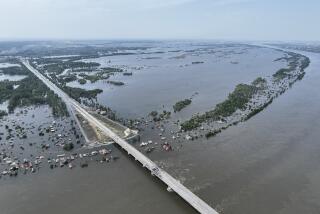Amid Poland’s Slag Heaps and Sulfureous Air, a Glimpse of Hope : Environment: Ecologists there and in some other parts of former Soviet bloc report their first tentative victories on nature’s behalf.
KRAKOW, Poland — For decades, the environmental news from Eastern Europe was as black as the corrosive soot that eats the ramparts and statues of Wawel Castle in this old royal city.
Now, more than three years after the end of communism and its damn-the-environment attitude, ecologists in Poland and some other parts of the former Soviet bloc are reporting their first tentative victories on nature’s behalf.
Some even talk hopefully of a day when blue skies will replace the poisonous haze and fish will thrive in formerly dead rivers.
Problems still outweigh the progress and Western experts say it will be 20 years before Eastern Europe can even approximate Western pollution standards. But there is an unmistakable sense that the cleanup has begun.
Poland has made the most dramatic progress.
Officials estimate the emission of pollutants has dropped by 30% since communism fell in 1989. They attribute the improvement to a combination of economic recession and changes in industrial practices.
“We are more and more a normal country, and slowly we are overcoming our environmental problems,” said former Environment Minister Maciej Nowicki. He heads Ecofund, a foundation to administer the millions Poland expects to get from Western creditors in Europe’s first “debt-for-nature” swaps. The idea is that creditors will cancel part of Poland’s foreign debt in exchange for cleaning up pollution or protecting certain lands or resources.
Dozens of the worst-polluting factories have been closed and the dirtiest coal is being stripped of sulfur. Hundreds of sewage and water plants are being built from the Baltic to the Carpathians, including a small one to benefit animals in the Continent’s last virgin forest.
Foreign aid is not the main source of money for the improvements. The government has raised nearly $1 billion a year for environmental projects, largely through fines and fees levied on industry, and has laid out a 20-year plan that envisages spending up to $35 billion.
Under an agreement reached in 1991, as much as 10% of Poland’s $33-billion debt to the Paris Club of Western nations may be applied to debt-for-nature swaps. The United States has taken the lead by assigning $360 million.
Less money is available to environmentalists elsewhere in Eastern Europe, but they, too, are making progress.
In the Czech Republic, some power plants in northern Bohemia are being shut down and filters are being installed in the others. As a result, sulfur dioxide emissions have been reduced by one-fifth since 1990.
Despite worker protests, Romania closed two rubber-dye factories in the Transylvanian town of Copsa Mica last year that had covered a nine-mile radius with acid, arsenic and various carcinogens.
Bulgaria is instituting an environmental cleanup fund based on the principle that polluters will pay.
Eastern Europe must spend its environmental funds carefully because the region’s lagging economies do not generate nearly enough money for the purpose, said Anand K. Seth, a World Bank environmental specialist in Washington.
He added, however, that 80% of correction is achieved with the first 20% of cost, so “lots can be done with modest expenditures if targeted right.”
Some ecologists, such as Andrzej Kassenberg of the Foundation for Sustainable Development in Warsaw, fear the rush to capitalism will cause Eastern Europe to repeat Western environmental errors.
Unless the region shapes its development to suit the environment, he said, the results will ape the West: too many roads and cars, chemical-intensive farming and mountains of solid waste from throwaway cans and plastic.
He urges that development be channeled to support such beneficial elements as mass transit, “ecological” tourism and expanded forests.
Krakow, its historic architecture victimized by pollutants from the belching plants and residential coal boilers of Upper Silesia, is an example of a city turning itself around.
A U.S.-financed project has constructed air-pollution monitors throughout the city. One even protrudes from the 600-year-old City Hall tower on the main square.
Factories, boilers and obsolete facilities at the nearby Nowa Huta steelworks have been shut down. Nowicki of the Ecofund said a single desulfurization device being installed at a suburban power plant will reduce sulfur levels in the area by 5% to 7%.
Many factories make improvements out of economic self-interest. “The fees and various penalties are important in their investment decision-making,” said Bogdan Polomski of the city environmental office.
The central government has 3,000 environmental inspectors who act as an ecological police force, tracking down big polluters, said Bernard Blaszczyk, undersecretary of state for the environment.
“Right now, we have had the first spectacular successes because it is easiest to correct the worst offenders first,” he said. “But afterward, it will be a slow process.”
Nevertheless, he said, “One can start to see some hope amid all the hopelessness.”
More to Read
Sign up for Essential California
The most important California stories and recommendations in your inbox every morning.
You may occasionally receive promotional content from the Los Angeles Times.










